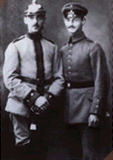 |
After World War
I, German Jews continued to view themselves as part of German
society. Jews, such as Albert Ballin and Walter Rathenau,
sought to demonstrate their love of the fatherland. Ballin
founded
the Hamburg-Amerika Line, a major shipping company with
international ties. In addition to his activities as a businessman,
he was an economic advisor to the Kaiser. In 1918 he committed
suicide in despair over Germany’s defeat in World War
I. |
 |
Photo: Albert
Ballin |
|
Poster: Hamburg-Amerika
Line Poster |
 |
Rathenau took over his father’s
position as president of AEG. During World War I, he helped
organize army supply lines and took part in the peace negotiations
at Versailles. In the Weimar Republic, he was the Minister
for Reconstruction and the Foreign Minister (1921-22). In
1922 an antisemite assassinated him. While he consistently
showed his loyalty to the fatherland, he expressed his skepticism
about how well Jews were accepted in German society,"In
the youth of every German Jew there is a painful moment he
will remember throughout his life; the moment he first becomes
fully aware that he has entered the world as a second-class
citizen, and that no amount of hard work and nothing he achieves
can ever rescue him from the situation." |
|
Photo: Walter
Rathenau |
|
|
"Stab in
the Back" Allegations
|
 |
At the end of World
War 1 in November 1918, the German generals surrendered rather
than experience defeat on the battlefield. Immediately, the
myth was circulated that Germany was “stabbed in the
back” by internal enemies—Jews, Communists, Socialists.
Even though Jews had served loyally in the German army, antisemitic
feelings in Germany were heightened by the “stab in
the back” allegations. In the popular mentality, Jews
were equated with Bolsheviks and were to be feared as a major
threat to the survival of Germany.
|
|
Photo: Herbert and Otto
Frank, Jews in the German Army 1916. From Anne
Frank Center USA. |
|
 |
Photos: (Left) Barbara
Rosenberg, currently
living in Columbia, South Carolina, is shown with her father's
picture. (Right) Barbara Rosenberg's
father, Simon Werthamer, born July 25, 1885, was a Jew from
Berlin who fought in the Austro-Hungarian Army during World
War I and later was murdered at Auschwitz. The photos are
used by permission.
|
 |
Antisemitic Atmosphere in the Inter-War Years
German and Austrian Jewish youth who were growing up in the inter-war
period recall that there were incidents of antisemitism. Nevertheless,
they went on with their normal routines and did not dwell on the
dangers of anti-Jewish sentiment. Catherine Norris, an American
photographer, who has traced the history of her grandparents and
parents during the 1920s and early 1930s in an area near Dachau,
Germany, points out that there were vacations and family gatherings
and little thought of the political landscape of the Weimar Republic.
When Hitler came to power on January 30, 1933, the situation for
Jews in Germany altered rapidly. In addition to antisemitic decrees
and the creation of concentration camps for political prisoners,
Jewish youth attending public schools encountered harassment from
teachers and students. These youth also recall how their German
friends suddenly turned against them for being Jewish. After 1938,
when Germany annexed Austria in the Anschluss, the same process
of non-Jewish neighbor turning against Jewish neighbor took place
in Austria at a much more rapid pace than it had in Germany earlier
in the 1930s.
The antisemitic atmosphere in the Reich during the inter-war years
had become so pronounced that in many cases Jewish parents decided
to send their children to England on the Kindertransport. Jewish
parents decided to send their children to England on the Kindertransport
with the hope that if the parents did not survive, at least their
children would. The era of emancipation in which Jews felt assimilated
within German society
had ended.
Jews
no
longer
had
equal political
and civil rights with non-Jewish citizens. |
Search |
Library
Holdings |
Related Links |
Bibliography |
Glossary |
Site Map
Frameworks 5.0
|
|
|
|
|
Webmaster at the Florida Holocaust Museum
Send education questions to:
© Copyright Florida Holocaust Museum, 2003; All rights reserved.
FAIR USE NOTICE: We make a concerted effort
to acquire permission from copyright owners prior to inclusion of material
on this site. However, this site may contain copyrighted material the use
of which has not always been specifically authorized by the copyright owner.
We are making such material available in our efforts to advance understanding
of political, human rights, economic, democracy, scientific, environmental,
and social justice issues, etc. We believe this constitutes a 'fair use'
of any such copyrighted material as provided for in section 107 of the
US Copyright Law. In accordance with Title 17 U.S.C. Section 107, the material
on this site is distributed without profit to those who have expressed
a prior interest in receiving the included information for research and
educational purposes. If you wish to use copyrighted material from this
site for purposes of your own that go beyond 'fair use', you must obtain
permission from the copyright owner. If you are a copyright owner who objects
to our use of your material for any reason, please inform us of your objection
and we will remove your material promptly. |
|
|

